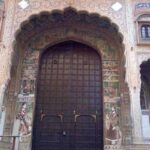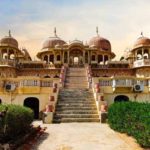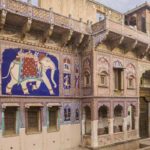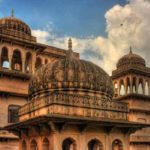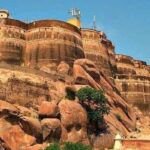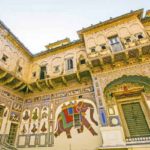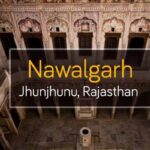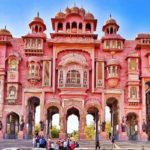Tourist Places To Visit Nawalgarh is a town founded by Thakur Nawal Singh in the 18th century, situated in the Shekhawati region of Rajasthan. He was then the ruler of the Shekhawati region of Nawalgarh and Mandawa. Havelis in Nawalgarh built in the year 1836 are characterised by craftily painted frescoes.
The Anandi Lal Poddar Haveli, built in 1920, is one of the town’s most famous attractions. Another tourist attraction is the Bala Kila Fort, which is known for the various paintings depicting local tales on its walls.
The Jodhraj Patodia Haveli, Bansidhar Bhagat Haveli, Chokhani Haveli, Roop Niwas Palace, Ganga Mai Temple and the British Clock Tower are some other big places to visit in the area.
The major tourist attraction in Nawalgarh is Nawalgarh Fort. The fort was established in 1737. It currently houses several government offices, as well as two banks. The massive construction of Roop Niwas Palace is about one kilometre away from the fort. Its elegance is enhanced by the garden and fountains within the palace. Now, the palace has been turned into a heritage hotel. Another attraction in Nawalgarh is the Anandi Lal Poddar Haveli. In the year 1920, the haveli was constructed. The Haveli actually has a school on their grounds. Several magnificent paintings decorate the walls of the Haveli. As the name implies, the Aath Haveli Complex has eight havelis, the only haveli in the Shekhawati region that has been restored to date. Visiting is worthwhile.
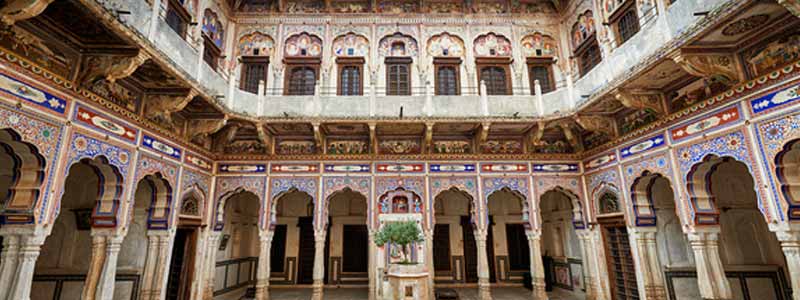
Murarka Haveli
This is the first Haveli that I have seen in the town. I entered through a very ornate wooden door, overhanging the abundantly painted walls and niches, and the Jharokhas. I think some recent attempts have been made by the owners to restore the Haveli. There is a small bookshop selling a book on a coffee table on the Haveli. Media reports on the Haveli are available for visitors to see. I bought a ticket and asked the guard to guide me through the Haveli River.
In a way, this guide showed me the different elements of the Haveli, which was an introduction to the traditional Shekhawati Haveli. In the middle, he showed me the courtyards, named Chowks. The size of the Haveli depends on how many Chowks it has. Small ones have one, while most have two and the occasional large ones have several more. He showed me the Baithak where business meetings were taking place, the small kitchens, and the large bedrooms at the top.
Stories from Indian scriptures are scattered all over, especially those from Krishna. My eye was really trying to remain focused on one painting. Each wall around me was a colour riot. Tulsi in the centre of the courtyard gave an impression of Haveli still being occupied. On the walls of the living area, I found the impression of Ahoi Mata that is worshipped by many Vaishya families during Navratri or on Ahoi Ashtmi.
I could see, from the top of the Haveli, a spot for horses with horses properly painted on the walls. Bang opposite this Haveli is a massive temple complex in traditional Rajputana architecture but in pristine white paint, quite a contrast to the vibrant Havelis that surround it.
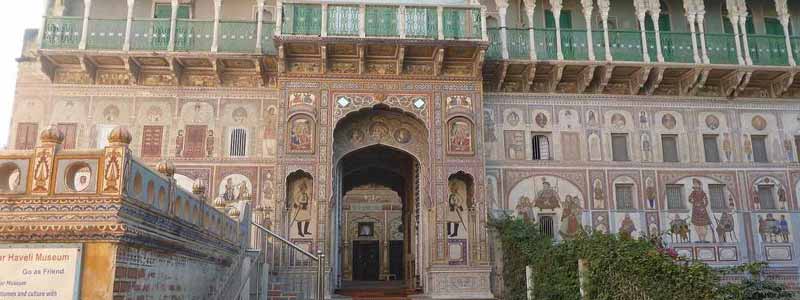
The Podar Haveli
Inside the Anandilal Poddar Haveli, which is another main attraction for visitors here, a museum is constructed. This part of Haveli was converted into Museum by Mr. Kantikumar R. Poddar who is the grandson of Anandilal Poddar. It is split into several sections that display musical instruments, kitchen utensils, jewellery, gems, etc. In addition to these, objects that reflect Rajput culture and traditions are also displayed in the Museum. It has large living rooms with enormous windows for sufficient light and air.
The front portion of the 110 ft Haveli measurement. x 25 ft. which is surrounded by stunning frescos. With the help of pillars and arches, the top balcony is well designed. With beautiful paintings, all the walls of the courtyard and baithaks are completely covered. With rare and beautiful murals, the walls, gates, and corridors are uniquely painted. The fresco designed gate between the outer and inner courtyard has been listed amongst India’s top 10 gates.
The paintings in the Anandilal Poddar Haveli draw visitors from all over. You are reminded of the glorious Rajput era by the interior of the Anandilal Poddar Haveli. The stunning Haveli at Nawalgarh is truly one of the ideal places to admire the beauty of Rajput art and architecture from floral swirls, motifs and intricate artwork. This is a paradise for art lovers and history lovers, a few miles from Mandawa in Rajasthan.
Shri Kalyan Ji Mandir
Lord Vishnu himself is Shri Kalyan Ji. Vishnu sustains and preserves the creation of Brahma in the Hindu triad of gods, until Shankar finally destroys it. Vishnu himself is enshrined in the form of Kalyan Ji in this temple. There’s an idol in the White Marble. It bears four arms. The beauty of the idol is attractive and charming. Kalyan means benevolence and redemption from misery. The lord here blesses the guests and believers with peace and welfare and bestows on them all wealth and material riches. He frees the devotees from miseries. The temple is served by Diggi’s Gujar Gaur clan of pandits. According to the clan, a “Pandi” is maintained.
Sheesh Mahal, Nawalgarh
In English, Sheesh Mahal translates to the Palace of Mirrors, and this beautiful building is no short of that. It is a beautiful building that includes maps of Nawalgarh and Jaipur with a ceiling mural.
The immense skill of Rajput artisans in the art of creating intricate frescoes is expressed in this architectural marvel.
Roop Niwas Palace
The Palace of the Roop Niwas is a cherished image of the previous period of monarchy. Located in Nawalgarh, one of the places enriched by history in the Shekhawati area of Rajasthan, the heritage hotel is spectacular. One of India ‘s architectural splendours is the frescoed Haveli, Roop Niwas. The complex artwork, craftsmanship and layout are exceptional. Experiencing the times of yore is ideal. Relax in the peaceful atmosphere and experience Rajasthan’s hospitality’s true essence. Intriguing discovery is made up of the local markets, temples, historical artefacts.

